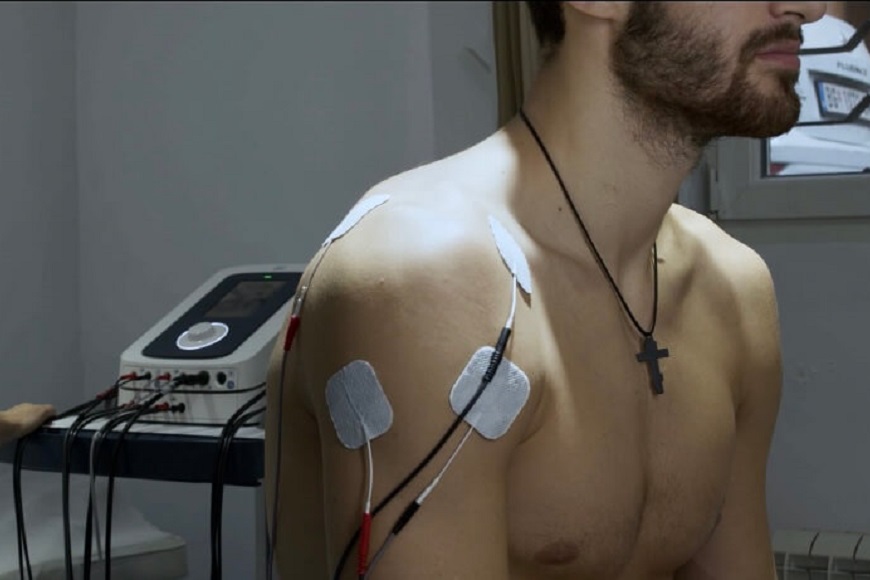Working Time
- Mon-Thu 08:00 - 20:00
Friday 07:00 - 22:00
Saturday 08:00 - 18:00
Contact Info
-
Phone: 011 240 40 46
011 407 82 31
064 258 89 85 - info@ffb.rs
Ask the Experts
Electrotherapy

About The Therapy
ELECTROTHERAPY is the application of current for therapeutic purposes. We use different types of currents, and the choice depends on their performance and the effect we want to achieve.
Galvanic Current
It is a one-way constant current that is applied in painful conditions, rheumatic diseases, swelling, injuries of the nerves and others. Indications for the application of galvanic current: neuralgia, neuritis, peripheral lesions and paralysis (rapid nerve and recovery), periarthritis, bursitis, tendonitis, enthesopathy (arthritis of the joints), arthritis, arthritis (painful knees, joints), cervical and lumbar syndrome, posttraumatic islands and hematomas, distortions (soft tissue injuries).
CONTRAINDICATIONS: skin defects at the site of application, eczema, adolescents, dermatitis, tissue in the tissue, febrile states, acute pulmonary processes, bleeding tendency to hemorrhage, cardiac pacemaker, decompression of the heart, lungs, kidneys and liver.
Electrophoresis
Electrophoresis is a method by which, in the fastest way, by using galvanic current, the necessary drug is applied, locally, precisely to the injured place, thereby circumventing the gastric tract and liver circulation. Depot medication is created in the treated site, and the action of the drug is longer.
Diadynamics
Diadynamic currents represent a combination of differently modulated impulses by intensity, shape and amplitude (pulse) and galvanic components. They have a pronounced analgesic effect, they work to reduce the island and improve circulation (spreads blood vessels, reduces the island and hematoma), reduces muscle spasms and thus reduces pain. They are also used to stimulate the muscles after a short or longer rest.
INDICATIONS for the application of DDS: arthrosis and arthritis in the stage of severe pain, cervical and lumbar syndrome, neuralgia, neuritis, radiculopathy, distortion, contusion, subluxation (soft tissue injuries), postraumatic contractions (stiffness of the joints), algodistrophic syndrome (Sudek syndrome) peripheral circulation.
CONTRAINDICATIONS: skin defects, gravidity, bleeding, all types of paralysis, paresis, acute and subacute thrombophlebitis and inflammation of deep veins; Calculose (stone) in the urinary and urinary tract
TENS (Transcute Electrical Nerved Stimulation)
TENS is one of the best methods in the fight against pain. It is used in acute subacute and chronic pain. The current works by blocking impulses for nervous fibers that are transferred to the central nervous system. It is applied in back pain, rheumatic pain, neuralgia, migraine and phantom pain, and others.
CONTRAINDICATIONS: skin injuries, metal in the field of prostration, pacemaker.
Interference Strucures
INTERFERENT STRUCTURES allow the patient to control pain. Interferential currents represent two circuits of medium-frequency currents that cross deep into the tissue to produce an alternating low-frequency current. They work to reduce pain (considered to be stronger than other types of currents), increase tissue circulation, and increase the flow of oxygen into the tissue, accelerate bone healing after fracture-making callus (can also be used when there is a metal implant in the body), stimulate recovery injured nerves and other.
CONTRAINDICATIONS: general CI, acute and subacute thrombophlebitis flebotrombosis, cardiac pacemaker, calculus (stone) of the urinary and urinary tract, heart rhythm disorders.
Russian Currents
Russian currents are used to stimulate healthy muscles, to increase strength and transverse muscle diameter. Russian physician Jakov Koc announced in 1977 that by using these currents, Russian athletes at the Olympics achieved an increase in muscle strength by 30-40 percent because he used these currents as additional training. These currents are also used in cases of prolonged sleep due to muscular atrophy, so the movement is difficult or impossible, and at a certain degree of scoliosis for the strengthening of the back muscles.
- Galvanic current - It is a one-way constant current that is applied in painful conditions, rheumatic diseases, swelling, injuries of the nerves and others.
- Diadynamics current - Diadynamic currents represent a combination of differently modulated impulses by intensity, shape and amplitude (pulse) and galvanic components.
- Interferental current - Interferential currents represent two circuits of medium-frequency currents that cross deep into the tissue to produce an alternating low-frequency current.






